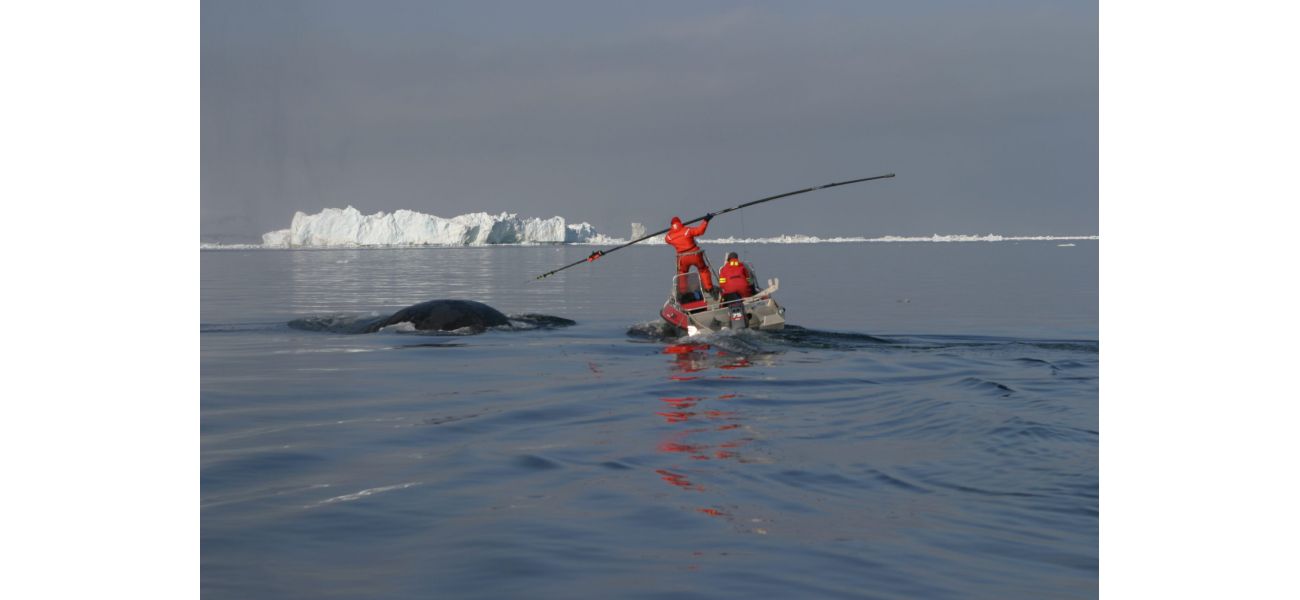Ancient whale discovered with a 100 year old harpoon in its side.
He didn't seem too bothered if he lived for another 100 years.
September 5th 2024.

Scientists have made a remarkable discovery about a species of whale that has been shrouded in mystery for centuries. The bowhead whale, known for its ancient origins and elusive nature, has been found to have a harpoon fragment dating back over a hundred years embedded in its body.
The first encounter with this enigmatic creature was off the coast of Alaska, where a harpoon tip was discovered lodged in its neck. After further research, experts identified it as a 19th-century bomb lance manufactured in New England around 1880. Despite the weapon likely exploding upon impact, the whale's tough layer of blubber and strong bones protected it, allowing it to live for another century.
John Bockstoce, curator at the New Bedford Whaling Museum in Massachusetts, commented on the discovery, saying, "It may have caused some discomfort to the whale, but it didn't prove to be fatal. It's incredible that it was able to survive for another 100 years."
At the time of its capture, the whale was estimated to be around 130 years old, making it potentially the oldest living mammal on Earth. However, despite its long lifespan, the bowhead whale remains a mysterious creature. Recent research has shed some light on their behavior, but much of their lives remain a mystery.
A team of divers from Japan's Hokkaido University, Denmark's Aarhus University, and the Greenland Institute of Natural Resources spent five months studying the diving patterns of 12 tagged bowhead whales in Greenland's Disko Bay. Their findings revealed that these whales dive in sync, sometimes for up to a week, even when separated by significant distances. This synchronized behavior may be linked to acoustic communication, suggesting that these whales may have long-range communication abilities, a theory proposed over 50 years ago.
Evgeny Podolskiy, an associate professor at Hokkaido University's Arctic Research Centre, expressed his fascination with this discovery, saying, "The idea of acoustically connected whales, diving alone but in sync, is mind-blowing. Our research provides a framework for studying the social behavior of these seemingly chaotic, free-roaming marine animals." He also hopes that more tagging data will be gathered in the future to further expand on these findings.
The bowhead whale, with its imposing size, distinctive dark coloration, and prominent white chin, is truly a magnificent creature. As filter feeders, they consume krill, copepods, and other small crustaceans by swimming with their mouths wide open. Female bowheads can reach impressive lengths of up to 59 feet and weigh around 80 metric tons, while males average around 52 feet.
Not only are bowhead whales some of the largest mammals on Earth, but they may also be the longest-living. Scientists believe they can live up to 200 years, with genetic analysis suggesting they may even reach 268 years. However, despite their incredible longevity, bowhead whales are considered endangered, with an estimated population of only 8,000 to 12,000 remaining. Their primary threats are humans and orca whales.
These whales are well-adapted to survive in the harsh Arctic conditions, with dense bones and a thick, foot-long layer of blubber that insulates them from the freezing waters. This blubber, crucial for keeping them warm, also acts as a natural shield against harpoon attacks. In fact, since 2001, six other whales have been found with similar harpoon fragments, showcasing the incredible resilience of these ancient marine giants.
The particular whale in question was captured in 2007 by a commercial whaling crew who found the fragment after cutting through its thick hide with a chainsaw. However, commercial whaling has since been banned worldwide due to an international agreement, providing these majestic creatures with some protection.
The discovery of a century-old harpoon fragment in a bowhead whale highlights the importance of protecting these ancient creatures. As we continue to uncover more about their behavior and longevity, it is crucial that we work towards preserving their habitat and ensuring their survival for generations to come.
The first encounter with this enigmatic creature was off the coast of Alaska, where a harpoon tip was discovered lodged in its neck. After further research, experts identified it as a 19th-century bomb lance manufactured in New England around 1880. Despite the weapon likely exploding upon impact, the whale's tough layer of blubber and strong bones protected it, allowing it to live for another century.
John Bockstoce, curator at the New Bedford Whaling Museum in Massachusetts, commented on the discovery, saying, "It may have caused some discomfort to the whale, but it didn't prove to be fatal. It's incredible that it was able to survive for another 100 years."
At the time of its capture, the whale was estimated to be around 130 years old, making it potentially the oldest living mammal on Earth. However, despite its long lifespan, the bowhead whale remains a mysterious creature. Recent research has shed some light on their behavior, but much of their lives remain a mystery.
A team of divers from Japan's Hokkaido University, Denmark's Aarhus University, and the Greenland Institute of Natural Resources spent five months studying the diving patterns of 12 tagged bowhead whales in Greenland's Disko Bay. Their findings revealed that these whales dive in sync, sometimes for up to a week, even when separated by significant distances. This synchronized behavior may be linked to acoustic communication, suggesting that these whales may have long-range communication abilities, a theory proposed over 50 years ago.
Evgeny Podolskiy, an associate professor at Hokkaido University's Arctic Research Centre, expressed his fascination with this discovery, saying, "The idea of acoustically connected whales, diving alone but in sync, is mind-blowing. Our research provides a framework for studying the social behavior of these seemingly chaotic, free-roaming marine animals." He also hopes that more tagging data will be gathered in the future to further expand on these findings.
The bowhead whale, with its imposing size, distinctive dark coloration, and prominent white chin, is truly a magnificent creature. As filter feeders, they consume krill, copepods, and other small crustaceans by swimming with their mouths wide open. Female bowheads can reach impressive lengths of up to 59 feet and weigh around 80 metric tons, while males average around 52 feet.
Not only are bowhead whales some of the largest mammals on Earth, but they may also be the longest-living. Scientists believe they can live up to 200 years, with genetic analysis suggesting they may even reach 268 years. However, despite their incredible longevity, bowhead whales are considered endangered, with an estimated population of only 8,000 to 12,000 remaining. Their primary threats are humans and orca whales.
These whales are well-adapted to survive in the harsh Arctic conditions, with dense bones and a thick, foot-long layer of blubber that insulates them from the freezing waters. This blubber, crucial for keeping them warm, also acts as a natural shield against harpoon attacks. In fact, since 2001, six other whales have been found with similar harpoon fragments, showcasing the incredible resilience of these ancient marine giants.
The particular whale in question was captured in 2007 by a commercial whaling crew who found the fragment after cutting through its thick hide with a chainsaw. However, commercial whaling has since been banned worldwide due to an international agreement, providing these majestic creatures with some protection.
The discovery of a century-old harpoon fragment in a bowhead whale highlights the importance of protecting these ancient creatures. As we continue to uncover more about their behavior and longevity, it is crucial that we work towards preserving their habitat and ensuring their survival for generations to come.
[This article has been trending online recently and has been generated with AI. Your feed is customized.]
[Generative AI is experimental.]
0
0
Submit Comment





